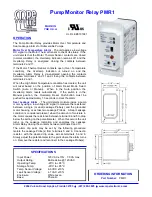
2–4
M-3520 Instruction Book
2.3
Configuration
Functions
Configuring the M-3520 Intertie Protection Relay
consists of enabling the relay functions to be used in
a particular application. Once the output contacts
(OUT1–8) are designated, each function will be
receptive, according to the status inputs designated
(IN1–6) to block the function.
Status inputs may also initiate other actions, such
as triggering the Oscillograph Recorder. The status
inputs and output contacts need to be chosen
before configuring the individual functions. Both can
be recorded on the
Relay Configuration Table
in
Appendix A.
■
■
■
■
■
NOTE:
At least one relay output must be selected
to enable a function, otherwise the function
is disabled.
Special Input/Output Considerations
Status input IN1 is
preassigned to be the 52b breaker
contact. The FL blocking input represents the
internally generated fuse loss status.
Outputs 1–6 are form “a” contacts (normally open)
and outputs 7 and 8 are form “c” contacts (center
tapped “a” and “b” contacts).
Outputs 1–4 contain special circuitry which allow
them to operate slightly faster than the other outputs.
Each output may be programmed for pulse operation.
The seal-in time delay setting for the particular relay
output determines the length of time that relay is
energized when programmed for pulse operation.
■
NOTE
: Output 8 has been especially designed to
be used as the Reconnect output. Any
protective function assigned to this output
will not display a target LED if it operates.
The following functions can be configured using
enable/disable output, and status input blocking
designations:
+ 21 Phase Distance zone #1, zone #2
•
25 Sync Check
•
27 Undervoltage #1, #2
•
27G Neutral Undervoltage
•
32 Reverse/Forward Power #1, #2
•
46 Negative Sequence Overcurrent, Def,
Inv
•
47 Negative Sequence Overvoltage #1,
#2
•
50 Instantaneous Phase Overcurrent
•
50G Instantaneous Neutral Overcurrent
•
51G Inverse Time Neutral Overcurrent
•
51V Inverse Time Overcurrent with Voltage
Control or Voltage Restraint
•
59 Overvoltage #1, #2
•
59I Peak Overvoltage
•
59G Neutral Overvoltage
•
60FL VT Fuse Loss
•
67 Phase Directional Overcurrent, Definite
Time and Inverse Time
•
67N Residual Directional Overcurrent,
Definite and Inverse Time
+ 78 Out of Step
•
79 Reconnect Enable
•
81 Frequency: #1,#2, #3, #4
+ 81R Rate of Change of Frequency #1, #2
“•” denotes Standard function, “+” denotes Optional
function
27 #1 PHASE UNDERVOLTAGE
disable ENABLE
27 #1 BLOCK INPUT
fl i6 i5 i4 i3 i2 i1
27 #1 RELAY OUTPUT
o8 o7 o6 o5 o4 o3 o2 o1
This designation is required for each relay function. After
enabling the function the user is presented with the follow-
ing two screens.
This screen assigns the blocking designations (up to six) for
the enabled function. “OR” logic is used if more than one
input is selected. If the “FL” is designated, the function will be
blocked by the internally generated fuse loss status.
This screen assigns the output contacts (up to eight) for
the particular relay function. If no output contacts are as-
signed, the function will be automatically disabled.
Summary of Contents for M-3520
Page 1: ...Instruction Book M 3520 Intertie Protection Relay ...
Page 83: ...2 50 M 3520 Instruction Book This Page Left Intentionally Blank ...
Page 95: ...M 3520 Instruction Book 3 12 This Page Intentionally Left Blank ...
Page 133: ...M 3520 Instruction Book 5 12 This Page Intentionally Left Blank ...
Page 195: ...A 20 M 3520 Instruction Book This Page Intentionally Left Blank ...
Page 213: ...D 12 M 3520 Instruction Book This Page Intentionally Left Blank ...










































